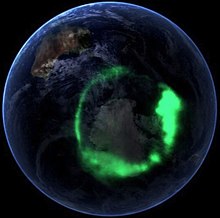The other day, a giant zit on the surface of the sun popped and sent a flood of protons and electrons sailing toward the earth. In truth, this sort of thing happens all
 the time, but this was an extraordinarily large pop. When these charged particles approach the earth, they get caught in our magnetic field and interact with atoms high in the atmosphere. Some atoms pick up electrons, others give them up, others move electrons from one location to another in the atom, each of which releases photons of different energies. A photon is a wave of electromagnetic radiation, which if at the right energies, our eyes detect as visible light, of different colors. This can often result in a beautiful arrangement of light and colors, often referred to as the Northern Lights, or the Aurora Borealis. (Aurora comes from the greek Goddess of dawn, and Borealis from the greek god of North winds).
the time, but this was an extraordinarily large pop. When these charged particles approach the earth, they get caught in our magnetic field and interact with atoms high in the atmosphere. Some atoms pick up electrons, others give them up, others move electrons from one location to another in the atom, each of which releases photons of different energies. A photon is a wave of electromagnetic radiation, which if at the right energies, our eyes detect as visible light, of different colors. This can often result in a beautiful arrangement of light and colors, often referred to as the Northern Lights, or the Aurora Borealis. (Aurora comes from the greek Goddess of dawn, and Borealis from the greek god of North winds). This display is something I have always wanted to see, but never gotten the chance. Supposedly, this large wave was possibly going to cause the northern lights to be visible as far south as mid-United States, but I haven't had a chance to see it. Typically, the aurorae tend to be seen at high latitudes, because the magnetic field lines are stronger there -- but during strong waves of the solar wind, they can be seen lower.
I wanted to name my daughter Aurora-- partly because I thought it was a beautiful enigmatic display, showing herself only secretly, and partly because the name Aurora Laura Roer was so fun to say. But my wife convinced me Abby was better. Abby means fathers deLight, so I still have the lights reference in them.
Random facts about the northern lights:
- They occur also in the south, called Aurora Australis
- They occur on other planets.
- They can be seen from space - the international space station has taken many beautiful pictures of it.
- The collisions occur about 50 miles above the earth, or roughly 1% of the radius of the earth above the earths surface.
- The auroras reach furthest toward the equators around midnight, so on any given day that would be the best time to try to observe them.
- Solar Flares, or "zit poppings" occur often -- once a week or so during good times and several a day during rough solar complexion. This varies in an 11 year cycle (why 11 years?!) and we are approaching a peak, 2013 should be a year of a lot of flares, and likely a lot more auroras visible. Perhaps the sun just ate a bunch of pepperoni pizza?

Wow I love the picture at the bottom of your post! I never knew they could be seen from space. I've always wanted to see them too. Maybe someday we can take our kid(s) on a trip to Alaska. 'Cause I've always wanted to visit there too. :)
ReplyDelete